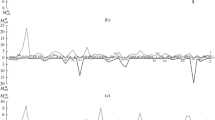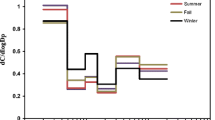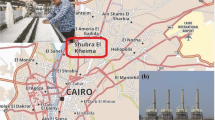Abstract
PM10 and PM2.5 samples were taken using a Gent sampler to characterize the atmospheric aerosol of Buenos Aires metropolitan area. A total of 114 samples were collected from October 2005 to October 2006 at one urban site, every third day, for 24 h. Samples were analyzed by neutron activation, and black carbon and mass concentration were determined. In both fractions, elemental and gravimetric mass concentrations were compared with historical data. Enrichment factors, backward trajectories and factor analysis were calculated. The attribution of pollution sources is discussed.
Similar content being viewed by others
Explore related subjects
Discover the latest articles, news and stories from top researchers in related subjects.Avoid common mistakes on your manuscript.
Introduction
The association of airborne trace elements with environmental issues is a useful tool to identify the most significant pollution problems in large urban and industrial areas of Argentina. The metropolitan area of Buenos Aires (AMBA), with about 14 million inhabitants, comprises the city itself and 24 neighbouring districts that belong to the province of Buenos Aires. It is located on a plain close to Rio de La Plata River, at about 160 km from the Atlantic Ocean. Road traffic emissions represent one of the major contributions to air pollution in AMBA, with more than 1 million light-duty vehicles, about 200,000 trucks and 15,000 buses that use natural gas, gasoline and diesel oil. Although several assessments have indicated the need of an air quality systematic surveillance, there is still no monitoring network in the largest urban area of Argentina.
The first multielemental characterization of Buenos Aires atmospheric aerosol, discriminated by particle size, was done by Plá et al. [1, 2] from 1994 to 1996. Mass concentration and 17 elements were determined by neutron activation analysis (NAA) in coarse (aerodynamic diameter between 2 and 10 μm) and fine (aerodynamic diameter <2 μm) fractions, collected at an urban and a semi-rural site, using a sampler developed at the University of Gent (Belgium). This paper is giving the results of the determination of the aerosol elemental profile for a different urban site in Buenos Aires, by collection of air particulate matter using the same Gent sampler.
Experimental
Airborne particulate matter (APM) was collected as coarse and fine fractions using a Gent sampler [3–5], at an urban site in AMBA, characterized by heavy and fast traffic. Sampling was carried out every third day, for 24 h from October 2005 to October 2006. Mass concentration was determined by gravimetry and all filters were weighed twice before and after being exposed. Black carbon was determined by reflectometry using a Smokestain Reflectometer M43D and all the determinations were done in three replicates. Air filters together with two certified reference materials, NIST 1633b Coal Fly Ash and NIST 1648 Urban Particulate Matter, for calibration purposes, were irradiated for 3 h at RA-3 reactor (thermal flux 3 × 1013 cm−2 s−1, 8 Mw) located at Ezeiza Atomic Centre (CAE, Argentine Atomic Energy Commission). Instrumental NAA was performed, measuring twice after 6 and 30 day decay. The measurements were carried out using GeHP detectors (30% efficiency, 1.8 keV resolution for 60Co 1332.5 keV peak) and concentrations for As, Ba, Br, Ce, Co, Cr, Cs, Eu, Fe, Gd, Hf, K, La, Lu, Na, Nd, Rb, Sb, Sc, Se, Sm, Ta, Tb, Th, U, Yb and Zn were calculated. IAEA SL-1 lake sediment was used as control sample, and accuracy was found to be generally better than 8%.
Results
A total of 114 pairs of coarse and fine filters and 9 pairs of blanks were collected and analyzed. Mass and elemental concentrations and black carbon results for PM10 fractions are shown in Table 1. According to particulate matter standards for Buenos Aires [6, 7] no PM10 pollution events were registered during the sampling period, with only one event for PM2.5 (19.84 µg/m3). Mass and elemental mean concentrations results were compared with data from a 1994–1995 study using the Gent sampler. Backward trajectories were calculated for all sampling days with NOAA HYSPLIT Model [8] for different heights, 250, 500 and 1000 m above ground level (Figs. 1 and 2). Using Sc as reference element and Mason’s crustal concentration values, enrichment factors were calculated (Fig. 3). After discarding elements with a high number of missing or below detection limit values, factor analysis was run using SPSS 13.0. For PM10, five factors were obtained using principal component analysis as extraction method and Varimax rotation (Table 2).
Discussion
If compared with 1994–1995 data, mass concentration values obtained in this paper are lower. The first ones range from 7.8 to 72 μg/m3 for PM10 and from 2.6 to 19.9 μg/m3 for PM2.5, while the present ones vary from 0.3 to 48.5 μg/m3 for PM 10 and from 0.1 to 19.8 μg/m3 for PM2.5. Keeping in mind the different characteristics of the sites, it can be said that the 2005–2006 location shows lower levels of atmospheric aerosol. Elemental mean concentrations found in this study are much lower than those found in the former one. Although vehicles are the main emission source for both urban sites, the first one had slow and heavy transit and more re-suspended dust, while the current sampling location is characterized by fast vehicle circulation. The fact that leaded gasoline was phased out in 1995, is reflected in the important decrease observed for Br: 13.9 (PM2.5) and 27.6 (PM10) ng/m3 against 0.885 (PM2.5) and 2.31 (PM10) ng/m3 in this work. The only pollution event registered considering particulate matter city standards [6, 7], was 19.84 μg/m3 for PM2.5 fraction on 22nd May; the corresponding PM10 value, 48.34 μg/m3, was among the highest (maximum: 48.50 μg/m3). The highest black carbon values for both fractions occurred also at this date. Backward trajectories for days with high mass concentration values, such as 22nd May (Fig. 1), shown mostly continental trajectories; while ocean trajectories corresponded mostly to days with lower mass concentrations as seen for 24th October (1.23 μg/m3 for PM2.5 and 5.88 μg/m3 for PM10) (Fig. 2).
While unit enrichment factor are considered as indication of soil origin, higher values suggest anthropogenic sources. Several elements such as Ba, Br, As, Sb, Se, Zn showed high enrichment for both fractions while for other elements, PM2.5 particles had higher values than PM10 (Fig. 3). These enrichments point to the contribution of anthropogenic emission sources as vehicles (Ba, Zn); incineration (Zn) and high T processes (As, Sb). Although Br appears highly enriched (Fig. 3), this has to be related to a source other than vehicles.
Bearing in mind principal component analysis results for PM10 (Table 2), source assignment shows a soil factor F1, with high loadings for Sc and Fe. As for F2, the presence of Zn and Ba in association with other elements can be related to abrasion of tires and motor oil [9, 10]. Br and Sb present in F3 might indicate mixed contribution of non ferrous metal processes, incineration and refineries emissions. F4 anthropogenic source remains unidentified with the contribution of Eu, La and Co. Contribution of Na in F5 is related to sea salt emissions. Factor analysis for the PM2.5 fraction shows traffic as main source, with some contribution from high temperature processes, soil, a marine component and an unidentified anthropogenic factor. Our results suggest that traffic is the most important source of environmental pollution at the studied site.
Conclusions
It can be concluded that the results obtained through factor analysis allowed the identification of the most important emission sources at the study site. Backward trajectories are an important tool to bear in mind at the moment of evaluating the concentrations of atmospheric pollutants in this zone. This paper gives new indications of atmospheric elemental levels and contributes to enlarge scarce existing data on the AMBA/APM profile. Results suggest that traffic is the most important source of environmental pollution at the studied site.
References
Plá, R., Moreno, M., Tafuri, V., Custo, G., Adler, M.: Study of air pollution in Buenos Aires city. In: Second research co-ordination meeting: applied research on air pollution using nuclear-related techniques, NAHRES 26, Appendix 1, pp. 1–14. IAEA, Vienna (1995)
Borthagaray, J.M., Fernández Prini, R., Igarzábal de Nistal, M.A., San Román, E., Tudino M.: La contaminación del aire. In: Diagnóstico Ambiental del Área Metropolitana de Buenos Aires, Sistema de Información Ambiental. FADU, pp. 35–105. Buenos Aires, Argentina (2001)
Maenhaut, W., François, F., Cafmayer, J.: The “Gent” stacked filter unit (STU) sampler for the collection of aerosols in two size fractions: description and instructions for installation and use. In: First Research Co-ordination Meeting: Applied Research on Air Pollution using Nuclear-related Techniques, NAHRES 19, pp. 249–263. IAEA, Vienna (1993)
Hopke, P.K., Xie, Y., Raunemaa, T., Biegalski, S., Landsberger, S., Maenhaut, W., Artaxo, P., Cohen, D.: Characterization of the Gent Stacked Filter Unit PM10 Sampler. Aerosol. Sci. Technol. 27, 726–735 (1997)
Markwitz, A.: Air pollution and its trends. Operating manual GENT Sampler RCA/07/013 (2000)
Ley 1356 de Preservación del recurso aire y prevención y control de la contaminación atmosférica para la ciudad autónoma de Buenos Aires (2004)
Decreto 3395/1996 (Anexo 3): Normas de Calidad de Aire Ambiente para la provincia de Buenos Aires (1996)
Draxler, R., Stunder, B., Rolph, G., Taylor, A.: Hybrid single-particle lagrangian integrated trajectories (HYSPLIT) version 4.8, NOAA-ARL (2007)
Monaci, F., Bargagli, R.: Barium and other trace metals as indicators of vehicle emissions. Water Air Soil Pollut. 100, 89–98 (1997)
Monaci, F., Moni, F., Lanciotti, E., Grechi, D., Bargagli, R.: Biomonitoring of airborne metals in urban environments: new tracers of vehicles emission, in place of lead. Environ. Pollut. 107, 321–327 (2000)
Acknowledgments
This work was done under IAEA Project RLA/7/011 ARCAL LXXX “Evaluation of the atmospheric pollution by particles and gases in cities densely populated in Latin America.”
Author information
Authors and Affiliations
Corresponding author
Rights and permissions
About this article
Cite this article
Jasan, R.C., Plá, R.R., Invernizzi, R. et al. Characterization of atmospheric aerosol in Buenos Aires, Argentina. J Radioanal Nucl Chem 281, 101–105 (2009). https://doi.org/10.1007/s10967-009-0071-1
Received:
Published:
Issue Date:
DOI: https://doi.org/10.1007/s10967-009-0071-1







